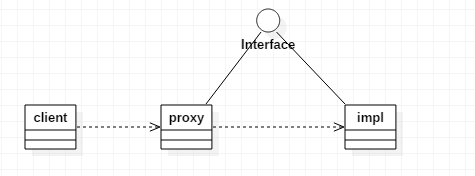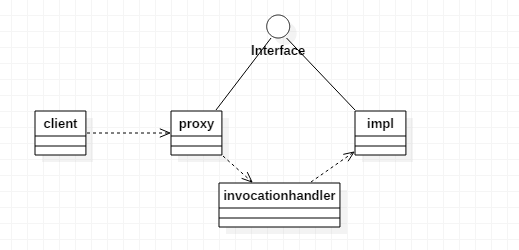代理模式
代理模式是非常常见的设计模式,在功能增强方面使用的特别明显,例如数据库连接池会使用代理连接代理真实的物理连接,以达到close只是归还到池中而不是真实关闭的效果。
模式介绍
代理模式可以说是特别容易上手的一个模式,因为现实生活中就有很多的代理,理解起来相对是比较容易的。 
- 代理类实现了和实现类一样的接口
- 代理类依赖实现类
- 调用其实使用的是代理对象
模式优点和缺点
优点
当对现有功能增强的时候不需要修改已经实现的部分,只需要写代理类即可,满足了开闭原则。
缺点
当接口发生变化的时候,不但实现类要改动,代理类也要跟着改动。例如新增和修改了接口,代理类作为接口的实现类,也需要实现这些。
#java的动态代理 动态代理的出现解决了模式的缺点
动态代理的简易展示
class TestInvocationHanlder implements InvocationHandler{ ITest target; public TestInvocationHanlder(ITest target) { super(); this.target = target; } @Override public Object invoke(Object proxy, Method method, Object[] args) throws Throwable { System.out.println("before"); method.invoke(target, args); System.out.println("after"); return null; }
public static void main(String[] args) { TestInvocationHanlder hanlder =new TestInvocationHanlder(new TestImpl()); ITest newProxyInstance = (ITest) Proxy.newProxyInstance(Main.class.getClassLoader(),new Class[]{ITest.class} , hanlder); newProxyInstance.hello(); }
上面代码锁展示的部分就是一个动态代理的操作过程。
主要就是通过newProxyInstance产生代理对象。
InvocationHandler的作用
看了代码的人一个最大的疑问就是为什么调用的代码最后会走入到InvocationHandler的实现中去。 我们先来看看newProxyInstance是做了什么操作
public static Object newProxyInstance(ClassLoader loader, Class<?>[] interfaces, InvocationHandler h) throws IllegalArgumentException { final Class<?>[] intfs = interfaces.clone(); Class<?> cl = getProxyClass0(loader, intfs); final Constructor<?> cons = cl.getConstructor(constructorParams); final InvocationHandler ih = h; return cons.newInstance(new Object[]{h}); }
以上代码是去除了检验操作的部分,我们可以清晰的看到,这里是构造了一个cl的对象,并且把InvocationHandler 作为构造的参数传入的。
getProxyClass0是一个创造字节码并且类加载的过程。 我们可以通过ProxyGenerator看到动态字节码生成后的结果。
byte[] proxyClassFile = ProxyGenerator.generateProxyClass("Proxy", new Class[] { ITest.class }); Files.copy(new ByteArrayInputStream(proxyClassFile), Paths.get("F:\\code\\Proxy.class"));
使用如上代码,就可以生成一个名叫proxy的字节码文件
public final class Proxy extends java.lang.reflect.Proxy implements ITest { private static Method m1; private static Method m3; private static Method m2; private static Method m0; public Proxy(InvocationHandler paramInvocationHandler) { super(paramInvocationHandler); } public final boolean equals(Object paramObject) { return ((Boolean)this.h.invoke(this, m1, new Object[] { paramObject })).booleanValue(); } public final void hello() { this.h.invoke(this, m3, null); return; } public final String toString() { return (String)this.h.invoke(this, m2, null); } public final int hashCode() { return ((Integer)this.h.invoke(this, m0, null)).intValue(); } static { m1 = Class.forName("java.lang.Object").getMethod("equals", new Class[] { Class.forName("java.lang.Object") }); m3 = Class.forName("proxy.ITest").getMethod("hello", new Class[0]); m2 = Class.forName("java.lang.Object").getMethod("toString", new Class[0]); m0 = Class.forName("java.lang.Object").getMethod("hashCode", new Class[0]); } }
以上也是省去了部分代码的结果,我们看到proyx是一个继承了reflect并且实现了我们的接口的类,他的构造参数就是InvocationHandler ,我们可以看到里面的方法,都是直接用InvocationHandler 的invoke来调用的,具体的方法,上面的声明的method就是具体方法调用时,就是调用invoke传入的参数。
动态代理流程
java直接生成了一个实现接口的字节码,对应我们的代理类,然后具体的流程必须我们编写invocationhandler来调用,代理类就是调用invocationhandler,以此达到动态的效果。 
真实运行起来的效果就是上面的类图,只不过这个proxy是动态生成代理类的过程,由于代理类是根据接口动态生成的,所以在接口变化的时候,只要是逻辑没变的情况下,动态代理是不需要修改代码的。
总结
动态代理的本质就是动态生成代理类,他解决了接口变化带来的代码变化,例如接口新增了方法a,那么不用修改代码,代理就可以做到对a的增强。但是他无法解决对部分方法做增强的问题,例如原来的方法a,b,c,是对a是用a逻辑增强,对b有b逻辑增强。这块逻辑都要写在invocationhanlder的invok方法里,当遇到这种情况,修改invocationhandler是必须的了。



